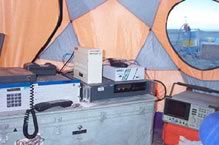Planetary Exploration Networking: The Internet for a crew on Mars
by Steve Braham


A crew inside FMARS - working and relaxing.
 |
|
When we finally send human explorers to the surface
of Mars, we are going to need ways to bring modern
networking to the Red Planet itself. NASA and Simon
Fraser University have been collaborating with Canada’s
Communication Research Centre (CRC), and with funding
from the Canadian Space Agency, on PlanetNet - a project
to investigate concepts for such a network.
Explorers on Mars will use a wide range of tools to
explore their surroundings. These will range from fixed
experiments such as monitoring weather, to advanced
teleoperated robots and spacesuited astronauts roaming
around the surface; experiments will need to constantly
deliver data back to base. Robots will send back high-resolution
data and receive commands; astronauts will
transmit their life signs and position, as well as
communicate through audio and video with base camp.


The satellite dish providing the HMP team with a communications link.
 |
|
The PlanetNet project is looking at advanced radio
systems that can transmit high-speed data over long
distances in the Martian environment, including reaching
into canyons where much of the interesting scientific studies
may happen. These systems use next-generation radio
technology developed in Canada, and will eventually form
the backbone for an internet over the entire Haughton-Mars
field region.
The base will communicate with Earth via high-speed
digital links, relaying all the telemetry data, as well
as TV images, for Humanity watching back home. The
communications network will be accessible to the
astronauts from anywhere. For the Haughton-Mars Project
(HMP), we use a high-speed space-based networking link
back to CRC to connect the region to the Internet back on
"Earth". We call this PUF -- the PlanetNet Uplink Facility.
Working with our PlanetNet partners, as well as HMP
members like Marc Boucher of SpaceRef, we have been
able to deliver live data of our research back to the world
via the network. PlanetNet provides the primary support
for returning field exploration data, telemedicine data, and
mission support operations for HMP.


Equipment inside the comms tent.
 |
|
Much work needs to be done. We need to understand
in what ways radios will behave differently on Mars relative
to our Earth-based Mars analogue sites. That means
understanding how the Martian atmosphere works, as well
as how the surface is different. We need to make systems
easy to use, easy to fix, flexible, and robust to extreme
temperature, pressure, and radiation effects. Finally, we
need to understand what is needed to make these systems
easy to deploy on Mars while in a space suit. Can robots
position communication elements? How do we power
everything, and detect problems? Can we minimize the
amount of time a crew must spend on EVA? We are finally
taking a first step in putting together the infrastructure that
will be needed by humans on Mars - and that makes the
research exciting for the PlanetNet team!
|

